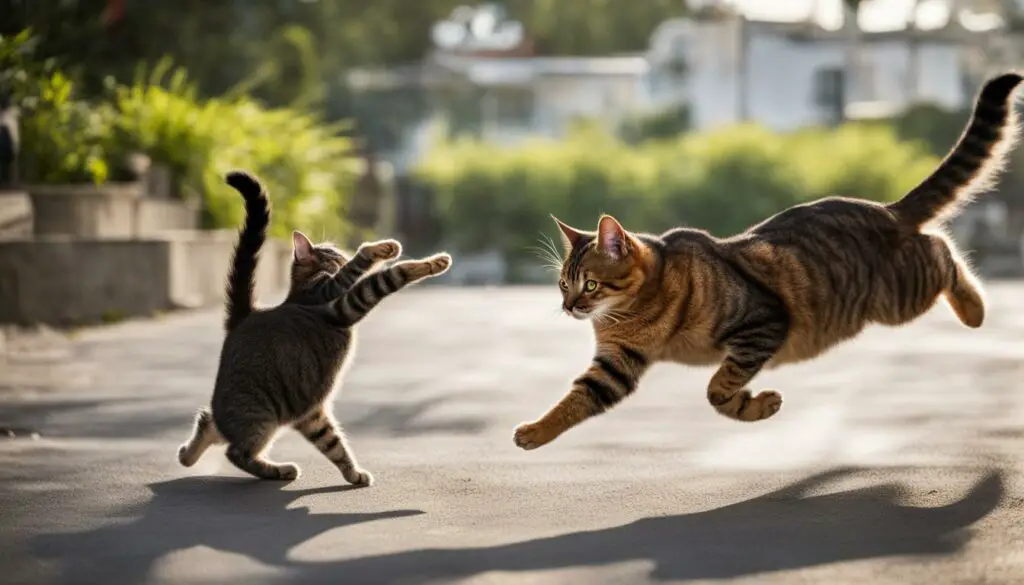If you’re wondering why your cat keeps attacking you, it’s important to understand the underlying reasons behind this behavior. Feline aggression towards their owners can be concerning and frustrating, but there are usually specific causes and solutions to address this issue.
Some cats may exhibit aggression due to play aggression, petting-induced aggression, fear aggression, territorial aggression, maternal aggression, redirected aggression, pain-induced aggression, and more. Identifying the specific type of aggression your cat is displaying can help you find the most effective strategies to manage and minimize these attacks.
In this article, I will explore common types of aggression in cats, their potential causes, and practical tips to address this behavior. By gaining a deeper understanding of your cat’s aggression, you can take proactive steps to create a harmonious and loving relationship with your feline companion.
Key Takeaways:
- Understanding the underlying reasons behind your cat’s aggression is crucial to finding effective solutions.
- Common types of feline aggression include play aggression, petting-induced aggression, fear aggression, territorial aggression, maternal aggression, redirected aggression, and pain-induced aggression.
- Identifying the specific type of aggression your cat displays will help guide you towards appropriate management techniques.
- Providing mental and physical stimulation, positive reinforcement and training, and a stress-free environment are essential in preventing and reducing cat aggression.
- If your cat’s aggression persists despite your efforts, seeking professional help from a cat behavior expert may be necessary.
Play Aggression: Understanding Your Cat’s Rough Play
Play aggression is a common behavior in cats that can sometimes result in attacks towards their owners. It occurs when a cat becomes overly excited during play or perceives a person’s hands and arms as prey-like objects. This can lead to biting, scratching, or pouncing, causing potential injuries. Understanding and managing play aggression is essential to ensure a safe and enjoyable playtime with your feline companion.

Redirecting your cat’s play aggression towards appropriate toys is key. Engaging your cat with interactive toys that mimic prey-like movements can help satisfy their hunting instincts and redirect their energy away from attacking humans. It is also important to establish boundaries during play by avoiding rough physical interactions and using toys at a safe distance from your hands and arms.
Remember, never punish your cat for play aggression, as it may exacerbate their behavior. Instead, use positive reinforcement by praising and rewarding your cat when they display appropriate play behavior, such as using their toys rather than attacking you.
In addition to redirecting their energy during play, providing regular exercise and mental stimulation can help reduce overall aggression in cats. This can be achieved through play sessions, puzzle toys, and interactive feeding methods that require problem-solving. A tired and mentally stimulated cat is less likely to engage in aggressive behaviors.
| Type of Play | Appropriate Behavior | Inappropriate Behavior |
|---|---|---|
| Interactive Toy Play | Pouncing on and batting at toys | Pouncing on and biting hands or feet |
| Solo Play | Chasing and pouncing on toys | Chasing and biting ankles or hands |
| Puzzle Toy Play | Using paws and tongue to retrieve treats | Knocking over the puzzle toy aggressively |
By understanding and addressing play aggression in cats, you can create a safer and more enjoyable environment for both you and your furry friend. Remember, always consult with a veterinarian or professional behaviorist if you’re facing challenges in managing your cat’s aggressive behavior.
Petting-Induced Aggression: Dealing with Overstimulation
Petting-induced aggression is a common behavior concern among cats. It occurs when a cat becomes overstimulated during petting sessions and responds aggressively. As a cat owner, it’s important to understand the signs of petting-induced aggression and learn how to manage and prevent it.
Signs of petting-induced aggression can include a sudden change in body language, such as flattening of the ears, twitching tail, or dilated pupils. The cat may also vocalize, growl, or bite and scratch. These behaviors indicate that the cat is feeling overwhelmed or overstimulated.
To prevent petting-induced aggression, it’s essential to read your cat’s body language and stop petting when they show signs of discomfort or aggression. It’s also important to reward your cat for staying calm during short petting sessions, gradually increasing the duration over time. Additionally, teaching children how to recognize and respond to aggression cues will help create a safe and harmonious environment for both the cat and the family.
Remember, each cat is unique, and what may be overstimulating for one cat may not be for another. By observing and understanding your cat’s individual preferences and limits, you can create a positive and enjoyable petting experience that minimizes the risk of aggression.
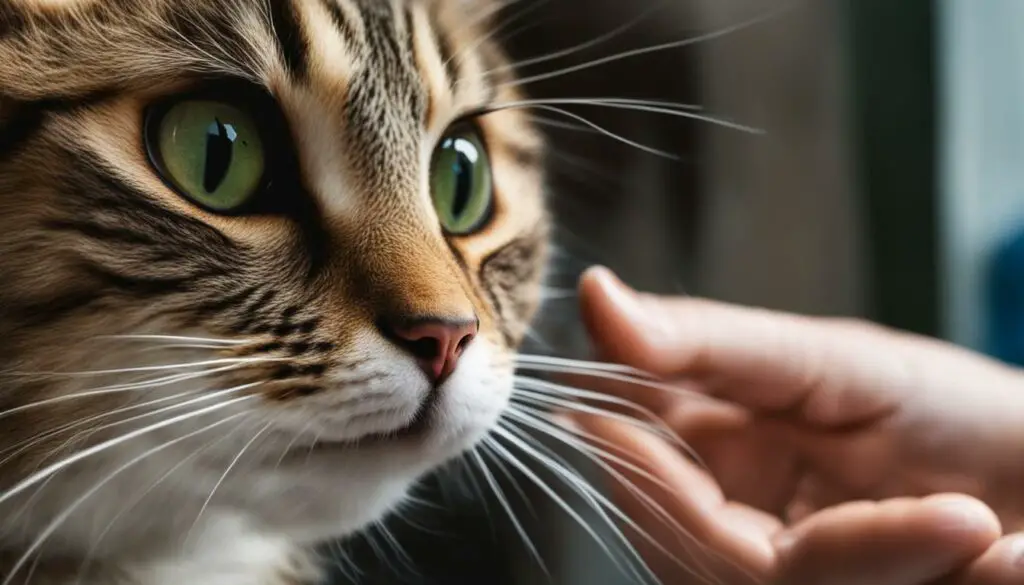
Fear Aggression: Helping Your Cat Overcome Their Fears
If your cat exhibits fear aggression, it’s crucial to understand their behavior and help them overcome their fears. Fear aggression occurs when a cat feels threatened or scared, and they respond by lashing out with scratching, biting, hissing, or growling. This aggression can be directed towards unfamiliar people or in specific situations, such as visits to the veterinarian.
To address fear aggression, it’s important to create a safe and secure environment for your cat. Providing a separate, quiet space during visits from unfamiliar people can help reduce their anxiety and prevent aggressive behavior. Additionally, desensitization techniques can be used to gradually expose your cat to stressful situations. This involves slowly introducing them to the triggers that cause fear aggression and rewarding them for calm behavior.
Understanding your cat’s body language is also crucial in managing fear aggression. Signs of fear in cats include flattened ears, dilated pupils, a lowered body posture, and a swishing tail. If you notice these signs, it’s important to give your cat space and avoid provoking them further. Rewarding calm behavior and avoiding punishment will be more effective in helping them overcome their fears.
Table: Signs of Fear Aggression in Cats
| Signs | Description |
|---|---|
| Flattened ears | The cat’s ears are pinned back against their head. |
| Dilated pupils | The cat’s pupils are larger than usual. |
| Lowered body posture | The cat’s body is crouched low to the ground. |
| Swishing tail | The cat’s tail moves rapidly from side to side. |
Understanding your cat’s body language is crucial in managing fear aggression.
It’s important to remember that fear aggression in cats can be complex and may require the assistance of a qualified cat behavior expert. They can assess your cat’s behavior, provide guidance on training techniques, and develop a customized plan to help your cat overcome their fears. With patience, understanding, and the right approach, you can help your cat feel more secure and reduce their fear aggression.
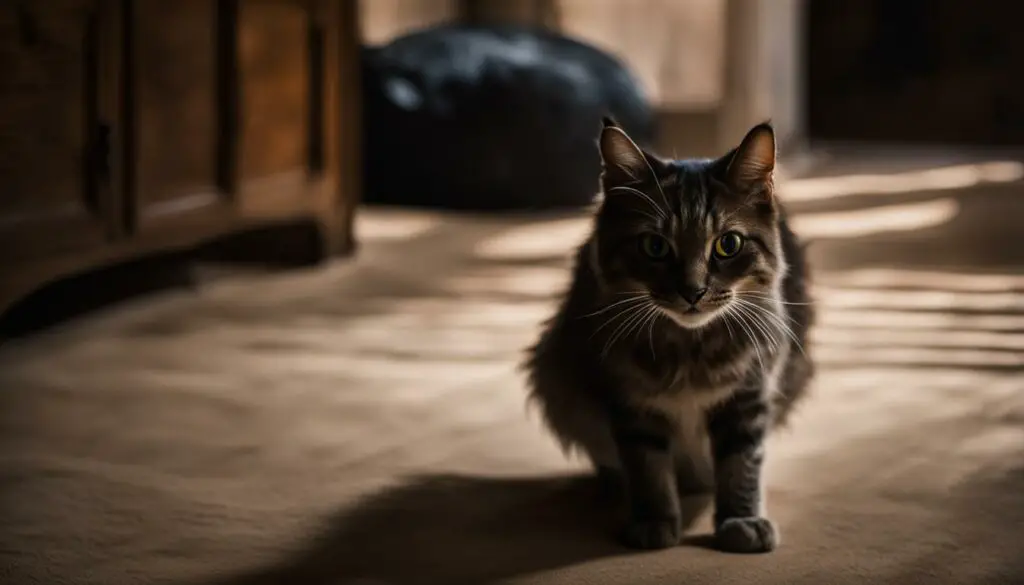
By addressing fear aggression and providing a supportive environment, you can help your cat overcome their fears and create a peaceful and loving relationship.
Territorial Aggression: Understanding Your Cat’s Need for Space
When it comes to cats, territorial aggression can be a common issue that many owners face. Cats are known for being fiercely protective of their space and may exhibit aggression towards anyone who enters their territory, whether they are strangers or even familiar people. Understanding and addressing this behavior is essential for maintaining a peaceful and harmonious environment for both you and your feline companion.
Territorial aggression in cats can manifest in various ways, including lunging, biting, scratching, or blocking access to rooms. This behavior is rooted in their natural instinct to protect their territory from perceived threats. While this aggression may be directed towards strangers, it can also extend to visitors, making it crucial to address the issue to ensure a safe and welcoming environment for guests.
To manage territorial aggression, it is important to take a non-confrontational approach. Ignoring the aggressive behavior and rewarding peaceful behavior towards others can be an effective long-term solution. Additionally, providing plenty of vertical spaces for your cat to claim, such as cat trees or shelves, can help alleviate their need to protect their territory. By creating an environment that allows your cat to feel secure and in control, you can help reduce their territorial aggression and promote a more peaceful coexistence.
Understanding and addressing territorial aggression is crucial for maintaining a peaceful and harmonious environment for both you and your feline companion.
| Signs of Territorial Aggression | Methods to Manage Territorial Aggression |
|---|---|
|
|
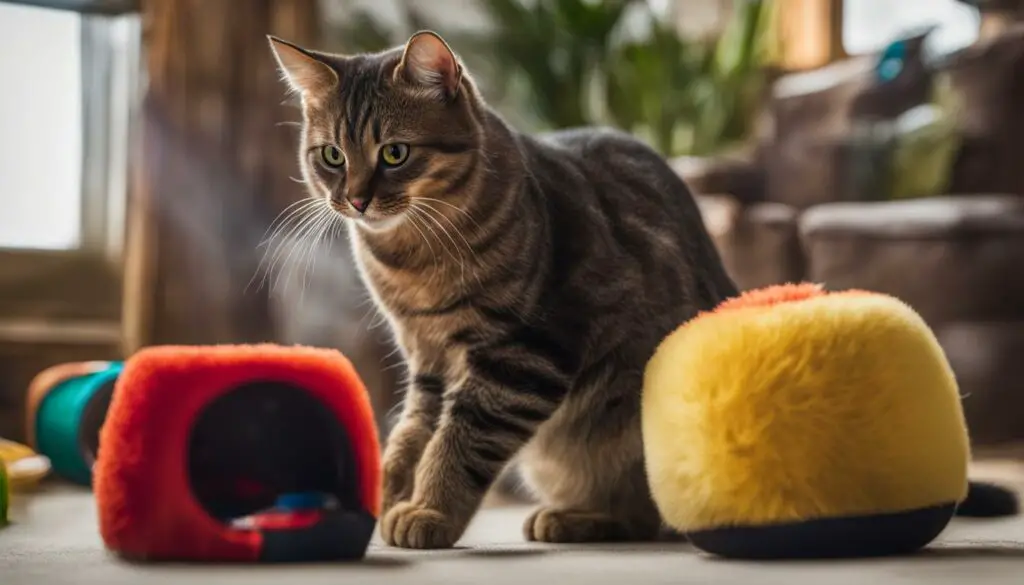
Addressing territorial aggression requires patience, understanding, and consistent training. It’s important to remember that your cat’s aggression is not a reflection of their love for you but rather a natural instinct to protect their territory. By implementing appropriate management techniques, providing a stimulating environment, and respecting your cat’s need for personal space, you can work towards resolving territorial aggression and fostering a peaceful relationship with your feline companion.
Maternal Aggression: Protecting Their Young
Maternal aggression is a natural instinct in female cats to protect their young. When a mother cat feels that her kittens are in danger, she may display aggressive behavior towards family members or even strangers. It’s important to understand and respect this behavior while also ensuring the safety of both the mother cat and the people around her.
The best approach to dealing with maternal aggression is to create a calm and secure environment for the mother cat and her kittens. Provide a quiet space where she can care for her young without feeling threatened. It’s also important to limit visitors and noise that could stress her out and trigger her aggressive behavior.
As the kittens grow and become more independent, the mother cat’s aggression should subside. However, it’s essential to give her the privacy and space she needs during this time. Gradually reintroduce human interaction, but always be cautious and respectful of her boundaries.
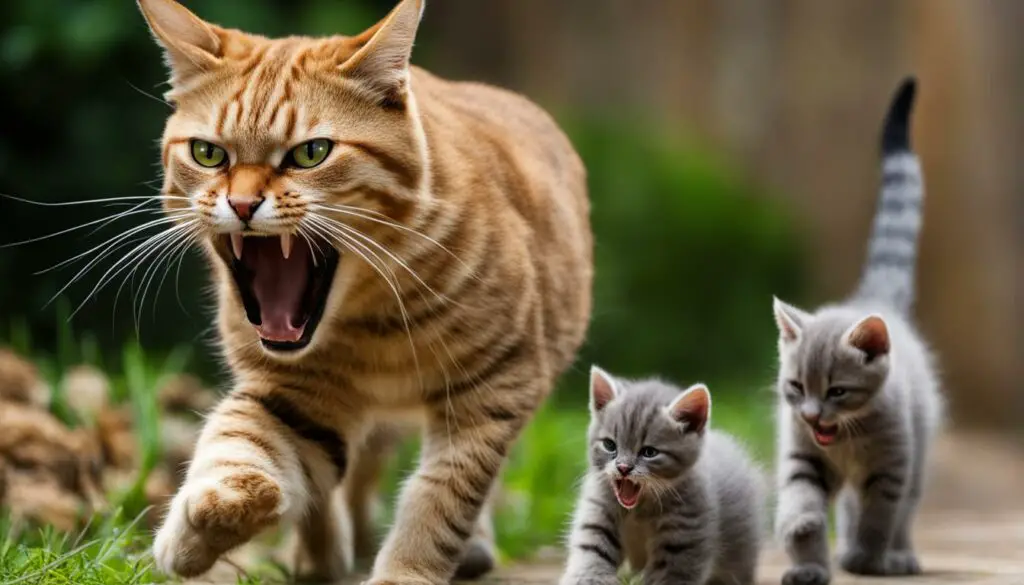
By understanding and accommodating the needs of a mother cat, we can help reduce maternal aggression and ensure the well-being of both her and her kittens. Patience, respect, and providing a safe environment are key in managing this type of aggression.
Redirected Aggression: Dealing with Over-Excitement
Redirected aggression is a common behavior in cats when they are unable to release their frustration or aggression towards the actual source of their arousal. This phenomenon occurs when a cat is stimulated by something outside, such as another animal or a loud noise, and then redirects its aggression towards another cat in the household, a human, or even an object. It’s important to understand how to manage redirected aggression to ensure the safety and well-being of both your cat and those around them.
One effective way to deal with redirected aggression is to redirect your cat’s attention to appropriate outlets. Interactive toys, scratching posts, and puzzle feeders can provide mental and physical stimulation, allowing your cat to release their excess energy in a positive and non-aggressive manner. By engaging your cat in play sessions and providing environmental enrichment, you can help prevent redirected aggression episodes.
In addition to redirecting your cat’s attention, it’s crucial to remove or avoid the outside stimulus that triggers the aggression. For example, if your cat becomes aggressive after seeing outdoor cats through a window, consider covering the window or limiting your cat’s access to that area. Removing the trigger can help prevent future episodes of redirected aggression.
When dealing with redirected aggression, it’s essential to create a calming environment. Calming products, such as pheromone diffusers or herbal remedies, can help reduce stress and anxiety levels in your cat. Additionally, providing a safe and secluded space for your cat to retreat to during episodes of redirected aggression can help them feel secure and prevent further escalation.
Table: Redirected Aggression Management Techniques
| Technique | Description |
|---|---|
| Redirected Play | Engage your cat in interactive play sessions with toys and laser pointers to redirect their energy. |
| Environmental Modification | Remove or minimize access to triggers that cause the redirected aggression, such as covering windows or using deterrent devices. |
| Calming Products | Use pheromone diffusers or herbal remedies to create a calming environment and reduce stress levels. |
| Safe Retreat Space | Provide a designated area, such as a quiet room or a cat tree, where your cat can retreat to when feeling overwhelmed or agitated. |
Redirected aggression can be a challenging behavior to address, but with the right management techniques, it can be effectively controlled. By redirecting your cat’s attention to appropriate outlets, removing or avoiding triggers, creating a calming environment, and providing a safe retreat space, you can minimize and prevent episodes of redirected aggression in your cat.
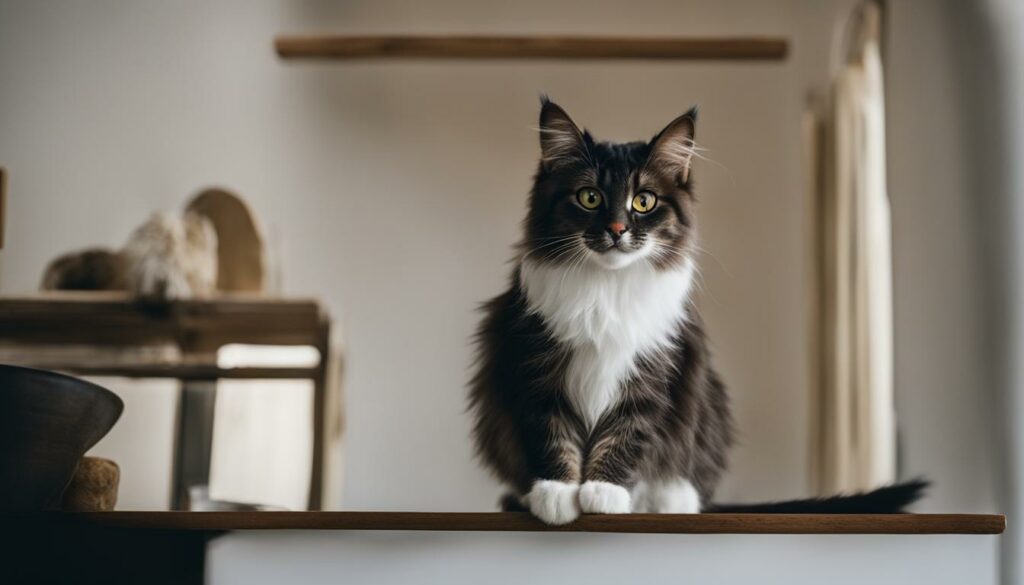
Pain-Induced Aggression: Addressing Underlying Health Issues
Pain-induced aggression is a type of feline behavior that occurs when cats experience physical discomfort or pain. Cats may exhibit aggression towards both familiar and unfamiliar individuals as a defensive response to their discomfort. It is important to address and alleviate the underlying health issues causing the pain-induced aggression in order to improve your cat’s behavior and overall well-being.
Identifying and treating the source of pain is crucial to resolving pain-induced aggression. If you notice your cat displaying aggression during petting or handling, or if they become aggressive seemingly without provocation, it is recommended to consult with a veterinarian. A thorough examination and diagnostic tests can help identify any medical conditions, such as arthritis or injuries, that may be causing your cat’s pain and subsequent aggression.
Table:
| Underlying Health Issues | Treatment |
|---|---|
| Arthritis | Medication, joint supplements, physical therapy |
| Injuries | Pain management, wound care |
| Urinary Tract Infections | Antibiotics, dietary changes |
| Dental Problems | Dental cleaning, tooth extractions |
“Identifying and treating the source of pain is crucial to resolving pain-induced aggression.”
Once the underlying health issues are addressed and treated, it is likely that your cat’s pain-induced aggression will diminish. However, it is important to remember that behavior modification may also be necessary to help your cat overcome any learned aggressive responses. Working with a qualified cat behaviorist or trainer can provide guidance and techniques to modify your cat’s behavior and promote positive interactions.
By addressing your cat’s pain-induced aggression with a comprehensive approach that includes medical treatment and behavior modification, you can help your cat feel more comfortable and secure, leading to improved behavior and a better quality of life for both you and your feline companion.

Dealing with Unprovoked Aggression: Seek Professional Help
If you have tried various strategies to address your cat’s unprovoked aggression and haven’t seen any improvement, it may be time to seek professional help. A qualified cat behavior expert can assess your cat’s behavior, identify the root cause of the aggression, and provide guidance on effective treatment and management techniques. They have the knowledge and experience necessary to understand the complexities of feline behavior and can offer valuable insights and solutions tailored to your specific situation.
Professional help can be especially beneficial if your cat’s aggression poses a risk to the well-being of other household members, including humans and other pets. The expert can guide you on how to safely interact with your cat, establish boundaries, and work towards minimizing aggressive episodes. They may also recommend specialized training exercises and behavior modification techniques to help your cat learn alternative behaviors and responses.
Keep in mind that resolving cat aggression requires patience, consistency, and a tailored approach. It’s important to follow the guidance of the professional and maintain open communication with them throughout the process. With their help, you can provide your cat with the necessary support and create a harmonious environment that promotes positive behavior and reduces the risk of aggressive incidents.

Cat Aggression Training and Treatment
When seeking professional help for cat aggression, it’s important to find a behavior expert who specializes in feline behavior and has experience working with aggressive cats. They can develop a personalized training and treatment plan that addresses your cat’s specific needs and aggression triggers. This may involve a combination of desensitization exercises, counterconditioning techniques, and positive reinforcement training.
Desensitization exercises involve gradually exposing your cat to the situations or stimuli that trigger their aggression, starting at a low intensity and gradually increasing it over time. Through a carefully planned process, your cat can learn to associate these triggers with positive experiences, reducing their fear or anxiety response. Counterconditioning techniques involve changing your cat’s emotional response to these triggers by replacing fear or aggression with relaxation or positive associations.
Positive reinforcement training focuses on rewarding good behavior and ignoring or redirecting unwanted behavior. By rewarding your cat for calm or appropriate responses and providing them with alternative outlets for their energy, such as interactive toys or scratching posts, you can help them develop more desirable behaviors and reduce their tendency for aggression.
Providing Mental and Physical Stimulation: Preventing Aggression
Preventing aggression in cats requires providing them with ample mental and physical stimulation. By engaging their minds and bodies, we can help redirect their energy and prevent frustration that may lead to aggressive behavior. Here are some strategies to consider:
Playtime is essential:
Cats need daily interactive play sessions to release their pent-up energy and engage their natural hunting instincts. Use toys that mimic prey, like wand toys or laser pointers, to keep the cat engaged and active. Play sessions should be short but intense, with frequent breaks to avoid overstimulation. Regularly rotating toys can also help maintain their interest.
Enrichment activities:
Provide a variety of enrichment activities to keep your cat mentally stimulated. Puzzle feeders, treat-dispensing toys, and catnip-filled toys can all provide mental challenges and keep them entertained. Creating vertical spaces, such as cat trees or shelves, can also give them a sense of territory and provide opportunities for climbing and exploring.
Socialization and interaction:
Socializing kittens from an early age is crucial to prevent aggression towards unfamiliar people or animals. Expose them to different experiences, sights, sounds, and people to help them develop positive associations and reduce fear or anxiety. Regular positive interactions with family members and visitors can also help them feel more comfortable around humans.
| Activity | Description | Benefits |
|---|---|---|
| Interactive play sessions | Engage your cat in play using wand toys, laser pointers, or interactive toys. | Helps release pent-up energy, redirects hunting instincts, and strengthens the bond between you and your cat. |
| Puzzle feeders and treat-dispensing toys | Provide toys that require problem-solving and reward your cat with treats or kibble. | Mentally stimulates your cat and keeps them engaged, preventing boredom and frustration. |
| Vertical spaces and hiding spots | Set up cat trees, shelves, or cat condos for climbing, perching, and exploring. | Allows your cat to claim territory, reduces stress, and provides exercise. |
| Socialization and positive interactions | Expose your cat to different experiences, people, and animals in a positive and controlled environment. | Helps reduce fear and anxiety, builds confidence, and fosters positive relationships with humans and other pets. |
“Providing mental and physical stimulation is crucial in preventing aggression in cats. By engaging their minds and bodies, we can redirect their energy and prevent frustration that may lead to aggressive behavior. Regular interactive play sessions, enrichment activities, and socialization can go a long way in keeping our feline companions happy and well-behaved.”
Remember that each cat is unique, and it’s important to observe and understand their individual preferences and needs. By providing mental and physical stimulation tailored to your cat’s personality and energy level, you can help prevent aggression and create a harmonious environment for both you and your feline friend.
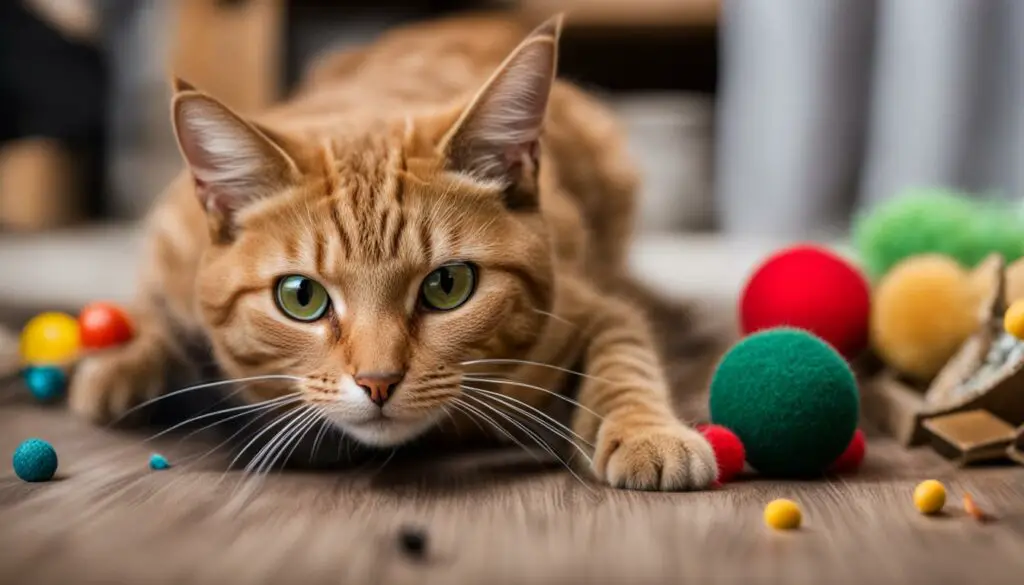
Positive Reinforcement and Training: Shaping Behavior
When it comes to managing cat aggression, positive reinforcement and training techniques play a crucial role in shaping your cat’s behavior. By using positive reinforcement, such as treats or praise, you can reward desired behaviors and discourage aggression. For example, when your cat demonstrates calmness or engages in appropriate play, it’s important to provide immediate positive reinforcement to reinforce these behaviors. This helps your cat associate positive experiences with good behavior.
Counterconditioning is another valuable technique in reducing cat aggression. This involves replacing the negative association that triggers aggression with a positive one. For instance, if your cat becomes aggressive when visitors come to your home, you can gradually introduce them to your cat in a controlled and positive environment. Over time, your cat will learn to associate visitors with positive experiences, leading to a reduction in aggression.
Understanding your cat’s body language is essential in effectively addressing and managing their aggression. Cats communicate their emotions through various body postures and vocalizations. By familiarizing yourself with these cues, such as flattened ears, dilated pupils, or a twitching tail, you can anticipate and defuse potentially aggressive situations before they escalate. Recognizing and respecting your cat’s boundaries is key to promoting a peaceful and harmonious relationship.

By utilizing positive reinforcement, counterconditioning, and understanding your cat’s body language, you can effectively shape their behavior and reduce aggression. Remember to be patient and consistent with your training efforts, as it may take time for your cat to learn new behaviors and overcome their aggressive tendencies. Seeking professional help from a qualified cat behavior expert can also provide valuable guidance and support in addressing and managing cat aggression.
| Positive Reinforcement and Training Techniques: | Advantages: |
|---|---|
| Using treats or praise to reward desired behaviors | Reinforces positive experiences and encourages good behavior |
| Counterconditioning | Replaces negative associations with positive ones |
| Understanding cat body language | Anticipates and defuses potentially aggressive situations |
Calming Techniques and Products: Promoting a Sense of Security
Dealing with cat aggression can be a challenging and frustrating experience for both you and your feline friend. Fortunately, there are various calming techniques and products available that can help promote a sense of security and reduce stress in your cat.
One effective technique is desensitization, which involves gradually exposing your cat to stressful situations or triggers in a controlled and positive way. For example, if your cat becomes aggressive during vet visits, you can start by simply bringing them to the clinic and rewarding them with treats and praise for calm behavior. Over time, you can gradually increase the duration of the visits and eventually incorporate examinations and procedures.
In addition to desensitization, there are also calming products that can help alleviate stress in cats. Synthetic pheromone diffusers, such as Feliway, release calming pheromones that mimic the natural facial pheromones produced by cats. These pheromones create a sense of familiarity and security, helping to reduce anxiety and aggression. Placing a diffuser in areas where your cat spends the most time can have a calming effect.
| Calming Techniques and Products for Cat Aggression | Benefits |
|---|---|
| Desensitization | Gradually exposes cats to triggers, reducing stress and aggression |
| Synthetic Pheromone Diffusers | Release calming pheromones, promoting a sense of security and reducing anxiety |
Conclusion
When dealing with cat aggression, it’s important to approach the issue holistically and address the underlying causes. Calming techniques and products can play a valuable role in promoting a sense of security and reducing stress in your cat. By combining these techniques with other management strategies, such as providing mental and physical stimulation, positive reinforcement, and creating a harmonious environment, you can work towards resolving your cat’s aggression and fostering a peaceful and loving relationship.
Addressing Environmental Factors: Removing Triggers
When dealing with cat aggression, it is essential to consider environmental factors that may contribute to the aggressive behavior. By identifying and addressing these triggers, you can help create a harmonious and stress-free environment for your cat. Three significant environmental factors that can impact cat aggression include environmental factors, dominance, and anxiety.
Environmental Factors
The cat’s environment plays a crucial role in their overall well-being and behavior. Certain environmental factors, such as the presence of other animals or loud noises, can trigger aggression in cats. To address this, it’s important to remove or avoid these triggers whenever possible. For example, covering windows or using window film can prevent a cat from reacting to outside animals, reducing territorial aggression. By creating a calm and secure environment, you can minimize stress and potential aggression in your cat.
Dominance
Dominance can also be a factor in cat aggression, particularly in multi-cat households. Some cats may display aggression towards other cats or even humans in an attempt to establish dominance. To address this, it’s important to provide each cat with their own space, resources, and territory. This can include separate feeding areas, litter boxes, and resting spots. Creating a harmonious environment and ensuring each cat feels secure and valued can help reduce dominance-related aggression.
Anxiety
Anxiety is another environmental factor that can contribute to cat aggression. Cats may become anxious due to changes in their routine, unfamiliar people or animals, or other stressful situations. To alleviate anxiety and reduce aggression, it’s important to provide plenty of hiding spots and perches for the cat to feel safe and secure. Additionally, desensitization exercises can help gradually expose the cat to stressful situations or triggers, reducing their anxiety and potential for aggression.
| Environmental Factors | Dominance | Anxiety |
|---|---|---|
| Remove or avoid triggers such as loud noises or the presence of other animals | Provide each cat with their own space, resources, and territory | Create a calm and secure environment with plenty of hiding spots and perches |
| Use window film or cover windows to prevent a cat from reacting to outside animals | Ensure each cat feels secure and valued | Engage in desensitization exercises to reduce anxiety |
| Offer mental and physical stimulation to alleviate stress |
By addressing environmental factors, such as removing triggers, managing dominance, and reducing anxiety, you can create a calming environment for your cat. Remember, each cat is unique, and it may take time and patience to find the right balance for your feline companion. Seeking guidance from a qualified cat behavior expert can also provide valuable insights and help resolve any persistent aggression issues.
The Importance of Socialization: Nurturing a Well-Behaved Cat
One crucial aspect of preventing cat aggression is socialization. By exposing kittens to various people, animals, and experiences from a young age, we can help them develop proper social skills and reduce the risk of aggressive behavior later in life. Socialization plays a vital role in shaping a cat’s behavior, allowing them to feel more comfortable and confident in different situations.
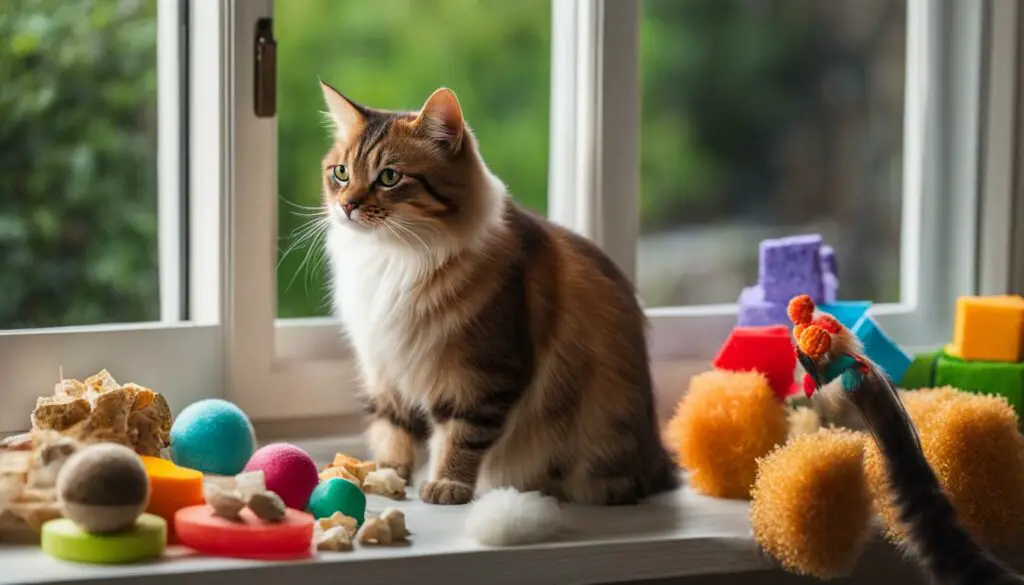
When kittens have positive interactions with humans and other animals during the critical socialization period, typically between two and seven weeks of age, they learn to trust and become familiar with different stimuli. These early experiences help cats understand that humans and other animals are not threats, reducing the likelihood of fear or aggression towards them in the future.
Proper socialization also helps cats become accustomed to common household experiences, such as loud noises, vacuum cleaners, and visitors. When cats are exposed to these stimuli in a positive and controlled way, they are less likely to perceive them as threats and exhibit aggressive behavior as a result.
Why is socialization essential for cats?
- Reduces fear and anxiety
- Promotes positive interactions with humans and animals
- Prevents aggressive behavior towards unfamiliar stimuli
- Increases adaptability to new environments
- Enhances overall well-being and quality of life
It’s important to note that some aggression may have a genetic component, and even well-socialized cats can display aggressive behavior in certain situations. However, by providing consistent socialization throughout a cat’s life, we can help them develop the skills and confidence needed to navigate the world with fewer instances of aggression.
Conclusion
Socialization is a key factor in nurturing a well-behaved cat and preventing aggression. By exposing kittens to various people, animals, and experiences from a young age, we can help them develop proper social skills and reduce the risk of aggression later in life. Socialization not only reduces fear and anxiety but also promotes positive interactions and increases adaptability. While genetic factors may contribute to some aggression, consistent socialization can greatly mitigate its occurrence. By fostering a positive and social environment, we can ensure a harmonious relationship with our feline companions.
| Benefits of Socialization | How to Socialize Your Cat |
|---|---|
|
|
Anticipating and Managing Aggression: A Holistic Approach
When dealing with a cat that exhibits aggressive behavior such as biting, scratching, or hissing, it’s important to take a holistic approach to anticipate and manage their aggression. By understanding the underlying causes and implementing appropriate strategies, you can promote a peaceful and loving relationship with your feline companion.
One effective way to manage aggression is through positive reinforcement and training techniques. By rewarding desired behaviors and discouraging aggression, you can shape your cat’s behavior over time. It’s also crucial to pay attention to your cat’s body language, as it can provide valuable cues about their emotional state and potential triggers for aggression.
In addition to training, providing mental and physical stimulation is essential in preventing aggression. Interactive play sessions, access to toys and scratching posts, and mental enrichment activities can help keep your cat engaged and prevent boredom or frustration, which can contribute to aggressive behavior. Socialization is also important, particularly during a cat’s early development, as it helps them develop proper social skills and reduces the risk of aggressive behavior later in life.
Creating a harmonious environment is another key aspect of managing aggression. Addressing any environmental factors that may contribute to aggression, such as removing triggers or providing hiding spots and perches for your cat to feel safe, can help alleviate stress and promote a sense of security. Calming techniques and products, such as synthetic pheromone diffusers, can also be effective in reducing anxiety and aggression in cats.
Table: Common Aggression Triggers and Management Strategies
| Aggression Triggers | Management Strategies |
|---|---|
| Pain-induced aggression | Consult a veterinarian to address underlying health issues causing pain |
| Petting-induced aggression | Read your cat’s body language and stop petting when signs of discomfort or aggression are present |
| Territorial aggression | Ignore the aggressive behavior and reward peaceful behavior towards others |
| Fear aggression | Desensitize your cat to stressful situations and create a safe and secure environment |
| Play aggression | Teach appropriate play behaviors and redirect energy towards toys |
| Maternal aggression | Provide a quiet space for the mother cat and limit visitors |
| Redirected aggression | Redirect your cat’s attention to appropriate outlets and remove or avoid triggers |

Anticipating and managing cat aggression requires a combination of understanding, training, environmental modification, and providing mental and physical stimulation. By taking a holistic approach, you can work towards resolving aggression issues and creating a peaceful and loving bond with your feline companion.
Conclusion
Dealing with cat aggression can be challenging, but understanding the reasons behind your cat’s behavior is the first step towards resolving it. Whether it’s play aggression, fear aggression, or any other type of aggression, there are various approaches you can take to manage and treat it effectively.
Seeking professional help from a qualified cat behavior expert can provide valuable insight into your cat’s aggression and guide you towards the most suitable training and management techniques. With their expertise, you can work together to address the underlying causes and create a harmonious environment for both you and your feline companion.
It’s also essential to provide your cat with ample mental and physical stimulation to prevent boredom and frustration, which can contribute to aggression. Interactive play sessions, toys, scratching posts, and enrichment activities can keep your cat engaged and reduce the likelihood of aggressive behavior.
Remember, managing cat aggression requires a holistic approach that combines understanding their specific type of aggression, addressing underlying causes, and creating a stress-free environment. By implementing these strategies and working patiently with your cat, you can foster a peaceful and loving relationship.
FAQ
Why does my cat keep attacking me?
There can be multiple reasons for your cat’s aggression, including play aggression, fear aggression, territorial aggression, maternal aggression, redirected aggression, and pain-induced aggression.
How can I address play aggression in my cat?
Teach your cat appropriate play behaviors, reward good behavior during play, and avoid using your hands and arms as play objects.
What should I do if my cat becomes aggressive during petting?
Read your cat’s body language, stop petting if they show signs of discomfort or aggression, and reward calm behavior during short petting sessions.
How can I help my cat overcome fear aggression?
Desensitize your cat to stressful situations, provide a quiet and separate space during visits from unfamiliar people, and create a safe and secure environment.
What can I do to address territorial aggression in my cat?
Ignore the cat’s aggressive behavior and reward peaceful behavior towards others, create a harmonious environment, and provide plenty of vertical spaces for the cat to claim.
How can I reduce maternal aggression in my cat?
Provide a quiet and low-stress space for the mother cat, limit visitors, and give her the privacy and space she needs to care for her young.
How can I manage redirected aggression in my cat?
Redirect the cat’s attention to appropriate outlets, like interactive toys, remove or avoid the outside stimulus triggering the aggression, and consider calming products or medications.
What should I do if my cat’s aggression is pain-induced?
Have your cat checked by a veterinarian to rule out any underlying health issues, and treat the underlying cause to resolve the aggression.
When should I seek professional help for my cat’s aggression?
If your cat’s aggression persists despite your efforts, it may be necessary to consult a qualified cat behavior expert for assessment and guidance.
How can I prevent aggression in my cat?
Provide mental and physical stimulation, engage in positive reinforcement and training, and create a harmonious and stress-free environment.
What techniques can help shape my cat’s behavior and reduce aggression?
Use positive reinforcement, reward desired behaviors, understand and interpret your cat’s body language, and anticipate and address potential aggression triggers.
Are there any calming techniques or products that can help manage cat aggression?
Create a calm and secure environment, use Feliway diffusers, provide hiding spots and perches, and consider desensitization exercises to reduce stress and aggression.
How can I address environmental factors that contribute to aggression?
Remove or avoid triggers, create a harmonious and stress-free environment, and address factors like dominance and anxiety that may contribute to aggression.
How important is socialization in preventing aggression in cats?
Socialize kittens from a young age, expose them to different experiences and people, and understand that genetics can also play a role in cat aggression.
How can I anticipate and manage aggression in my cat?
Take a holistic approach by understanding the specific type of aggression, addressing underlying causes, providing mental and physical stimulation, using positive reinforcement, and creating a harmonious environment.
Source Links
- https://www.worldsbestcatlitter.com/2021/01/how-to-solve-unprovoked-aggressive-cat-behavior/
- https://www.petmd.com/cat/behavior/why-does-my-cat-attack-me-unprovoked
- https://vcahospitals.com/know-your-pet/play-and-predatory-aggression-in-cats

